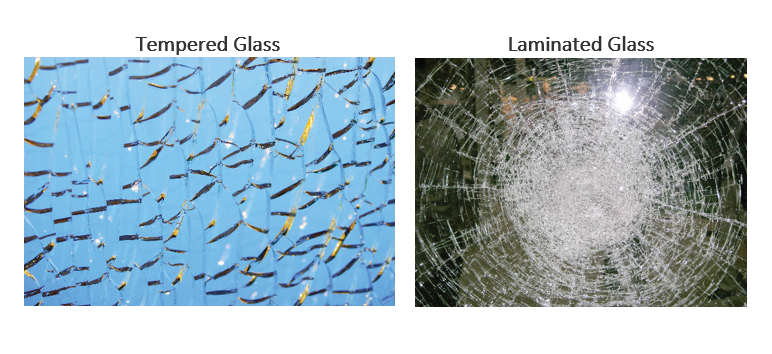
Difference
Laminated glass and toughened glass. They are frequently mistaken for one another and confused as being one and same product. They’re not.
While both are types of safety glass and are superior to standard glass, laminated glass and toughened glass differ from each other significantly in a number of areas.
Similar in that both offer better protection against break-ins, flying objects and severe winds when used on home interiors, laminated glass and toughened glass each defend properties in their own unique way, primarily in how they react when shattered.
In this blog we will explain the core differences between laminated glass and toughened glass, from the manufacturing process to how each reacts upon impact.
Knowing the difference between these two types of safety glass will give you a better understanding of which can offer suitable security for your windows, doors and rooflights.
Laminated glass is most known for being used on the windscreens of the majority of the world’s cars. This global use can be put down to what happens when laminated glass shatters.
When smashed, laminated glass holds in place and does not break up into large jagged shards or hundreds of little pieces. Instead, it keeps in place long enough for a replacement to be found.
This happens thanks to the plastic (polyvinyl butyral) interlay that is sandwiched between two glass sheets during manufacture. This bonds the two panes together like a glue so that even when the glass breaks, its fragments keep binding on the thin film.
his highly practical safety feature greatly reduces the chances of injury occurring from falling glass.
In addition to this, as the panes do not burst apart on impact, laminated glass leaves no hole behind for intruders and thieves to crawl through. Laminated glass also offers far superior UV resistance and sound proofing to annealed glass.
There are several different types of laminated safety glass built to withstand a specified level of attack. These include for blast-resistance glass, fire-resistance glass, bullet-resistance glass and solar control laminated glass.
Toughened glass, also known as tempered glass after its method of production, is a type of safety glass that is five times stronger than annealed and laminated glass of the same size and thickness.
Toughened glass gets this strength from the tempering process which sees it subjected to intense heating followed by rapid cooling during manufacture.
This toughness gives tempered glass a far higher load and breakage resistance. Toughened glass needs to be hit a lot harder than other safety glass in order to break.
Whereas laminated glass holds in place when shattered, toughened glass breaks up into hundreds of tiny pieces. You will probably have seen this on the floor where a telephone box or bus stop had been vandalised.
This method of breaking lowers the risk of injury compared to annealed glass which breaks up into larger, jagged pieces more likely to injure anybody in close proximity.
Tempered glass has a heat resistance four to five times stronger than standard glass and can withstand high temperature changes up to 250°C.
The question of whether to opt for toughened glass or laminated glass on an application does not have a definitive answer. Except for when its glaringly obvious, i.e. on a car windscreen, it's usually down to personal preference.
If comparing the two on security, toughened glass is the stronger glass and requires far greater force to be shattered. However, when it does, the area the glass was protecting is left exposed.
This is far less of a worry with laminated glass, as the glass stays in place when shattered. However, as laminated glass is not as resistant to breakage as tempered glass, accidental impacts, such as a stray ball or other flying object, are more likely to cause the glass to break and therefore need replacing.
-
- bmgroup@mail.com
-
- Phone
- +61419345002
-
- Address
- Unit 19/ 32 Dunheved circuit, St. Mary’s 2760






